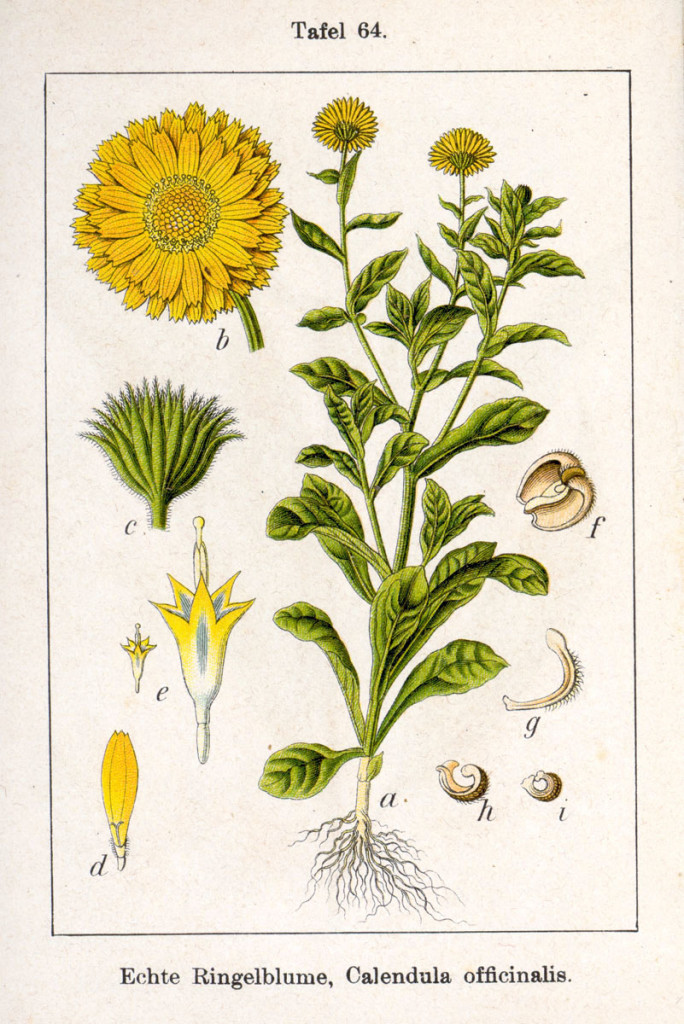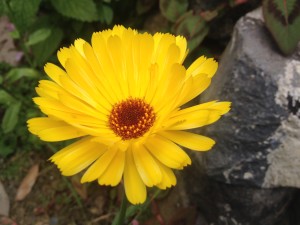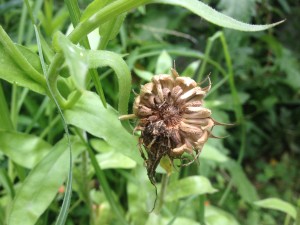Calendula officinalis is commonly known as pot marigold or just Calendula. The name comes from the Latin kalendae “first day of the month” in the Roman calendar, perhaps because it can be found flowering at the beginning of most months of the year.
Description
Calendula are hardy annuals grown for their cheery yellow and orange flowers and medicinal and culinary properties. Each plant will reach a height of around 50-70cm with an upright growing habit. Flowers are up to 7cm across occurring from Spring to Autumn where weather remains cool.
Ideal Growing Conditions
They need a sunny spot and well drained to poor soil and will produce a profusion of blooms from mid-Spring onwards. Dead-heading will prolong flowering. Calendula can be susceptible to powdery mildew in humid conditions and may also be troubled by rust, caterpillars and cucumber mosaic virus.
Propogation
Sow the initial plant in situ in Spring or Autumn. They self seed easily after producing large curly seeds that are also easily harvested. Calendula seed so readily that you can expect a succession of plants through the season as smaller ones begin to grow up underneath the parent plant. Sometimes they are overly eager and small babies may need transplanting to another bed. However they are easily removed. Deadheading will also help prevent excessive self seeding.
Companion Planting
Marigolds are often used in companion planting. The attract predators such as hoverflies which eat aphids and they repel pests such as asparagus beetle. They will also lure blackfly away from other plants but may need some protection themselves should they do too good a job at this.
Uses
For family fun:
They are a great plant for children to grow as their big seeds are fun for kids to harvest and their petals are used for anything from fairy soup to squishing for paint. Both adults and children will also enjoy drying the petals as the colour remains vivid.
Culinary:
Use the fresh petals as a garnish in salads or to decorate baking and the young leaves as a salad green. Some sources mention its use as a poor mans saffron when used in rice and soup.
Medicinal:
Calendula is a bitter-sweet herb that soothes inflammation, controls bleeding, clears infection and heals tissue. It also supports heart health and stimulates the liver, gall bladder and uterus. It can be used externally for problems of the skin such as eczema, athletes foot, varicose veins, conjunctivitis, leg ulcers, minor injuries, nappy rash , cradle cap and sore nipples in nursing mothers. Internally it can be used to treat menstrual problems, gastric ulcers, colitis, diverticulitis, hepatitis, swollen glands, glandular fever, pelvic inflammatory disease, disorders of the liver and gall bladder, and as a detoxicant, in chronic skin disorders such as eczema and acne.
Toxity
It is not to be confused with French marigold (Tagetes patula) which is not good to eat but is still grown as a fabulous companion plant, deterring pests.
Sources
The Royal Horticultural Society: Encyclopedia of Herbs and their uses, DK, 2002
The River Cottage Herb Handbook, Nikki Duffy, 2012

![By MarkusHagenloche [CC BY-SA 3.0 (http://creativecommons.org/licenses/by-sa/3.0/), GFDL (http://www.gnu.org/copyleft/fdl.html)], via Wikimedia Commons](https://meadowsweet.co.nz/wp-content/uploads/2015/12/Ringelblume-orange-gelb-e1449217451559.jpg)





